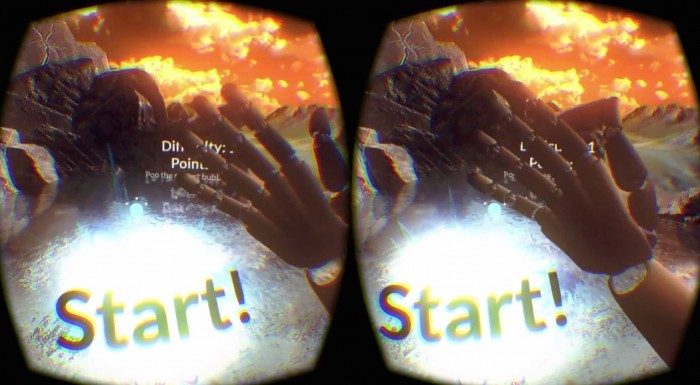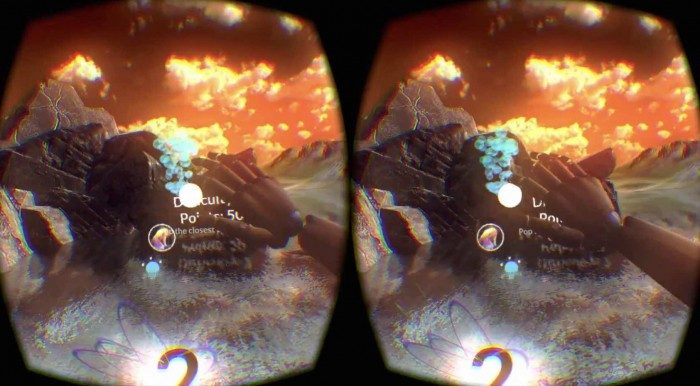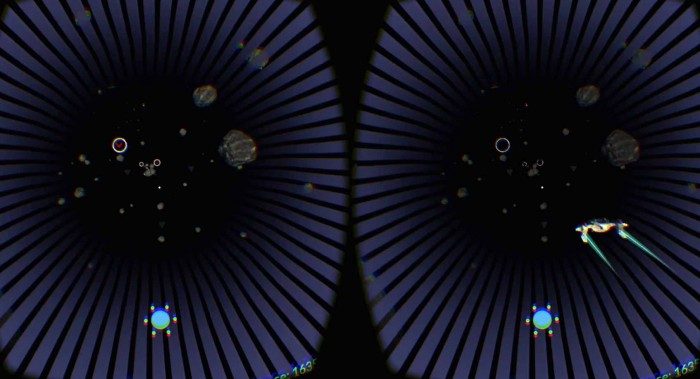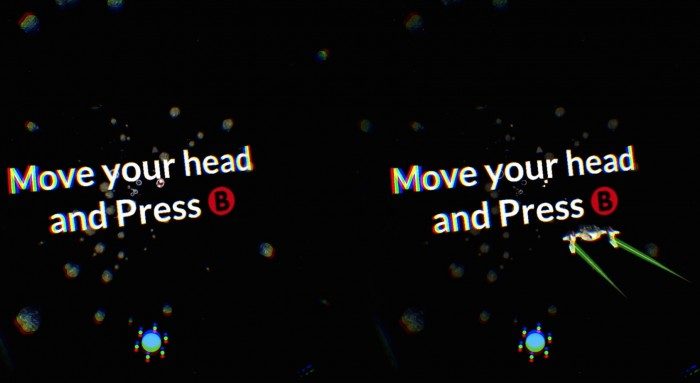Diplopia is a virtual reality title designed to provide targeted exercises for those suffering from vision issues. The team behind the application are rebranding, changing their name to Vivid Vision. Brian Hart caught up with CEO James Blaha to get up to speed on the latest in virtual reality vision therapy.
Over 20 million people in the US alone suffer from lazy eye, a condition which renders one of the eyes weaker than the other leading to double vision, also known as Diplopia.
I first found Vivid Vision (formerly Diplopia) at last year’s Silicon Valley VR Conference and Expo. Company CTO Manish Gupta walked me through a demo, and we sat and chatted about their product, as well as possible medical uses of VR in general. After running into CEO James Blaha at a recent event, I invited him by the office to catch up.
The following Q&A has been edited for brevity and clarity.
Brian: James, thanks for stopping by. I think the last touch point that you had with Road to VR was early last year when you were on the Rev VR podcast. I’m hoping to sort of catch up on what you guys have been working on recently, try to talk about the original business strategy, how you’ve pivoted, and what the future looks like. I understand you have trials going on. So let’s start at the beginning, what can you tell us about what you’re developing and what you’re trying to treat?
James: Right now we’re working on a virtual reality system focused on treating ‘Lazy Eye’ (or ‘Amblyopia’) and ‘Strabismus’. For people who don’t know, Strabismus is ‘Cross Eyes’, so one of the eyes isn’t aligned with the other one, and Lazy Eye is basically reduced function in the eye even though there isn’t really anything physically wrong with the eye; basically the brain can’t properly use the data that’s coming in from one of the eyes.
Brian: This is something you’re looking to use virtual reality to treat. What are the other treatments available at the moment? How would I have tackled this issue 5 years ago?
James: So, 5 years ago — they first of all would’ve told you if you’re older than 10 you can’t do anything. It was called this idea of ‘The Critical Age’, about 9 or 10 years old, that the brain wasn’t plastic enough after that age to make any changes to the visual system. Only in the last 3 or 4 years has there been a lot of recent research showing that this isn’t really true. What’s closer to the truth is it’s a lot harder to change, especially if you only give the person a visual stimulus that they would see in real life. If you can give them visual stimulus that’s really different from real life — present the same object differently to both eyes, something we can easily do in VR — those kinds of visual stimulus can spur bigger changes, even in adult brains.
Brian: So is it about strengthening the weaker eye using virtual reality, essentially?
James: What’s happened with most people who have Lazy Eye, is that when they’re very young, their brain has learned to ignore their weaker eye basically, or just kind of disregard everything coming from it. So our main purpose or goal is to overcome that suppression of the weaker eye. Changing the visual stimulus to the weak eye will increase the signal. It will basically tell their brain there’s something in this eye worth paying attention to, you really should be looking at it. You do that for long enough and the brain starts saying ‘okay, yeah, I can use this eye again; I can use it with my good eye’, and you start training binocularities, so people can gain that perception.
Brian: How has your business strategy shifted since we talked last year?
James: Last year when talking to Reverend Kyle, the goal was to get something out directly to people, and we’ve recently in the last few months kind of switched gears to go into ophthalmology clinics first. So we’re still planning on releasing something to the public, but it became pretty clear that the hardware is just not ready yet. The DK2 is not a consumer product as Oculus likes to remind us.
A lot of the people who are going to be buying our software are not gamers, they’re not computer people, they’re normal people who can’t set something up like a DK2 with all of the current kind of difficulties that come along with that.
Brian: So is it a hardware challenge, or is it a software challenge on the Oculus side? Is the DK2 good enough, it’s just that the experience of setting things up is horrendous?
James: I think it’s primarily the hardware side of things, rather than the software side of things.
Brian: Okay, what needs to improve in the hardware, just better resolution?
James: It just doesn’t work on every system; direct mode doesn’t work on every system.
Brian: Right.
James: We have hundreds of people using our software right now, and so we’ve seen kind of the reality, if you put it on all these different hardware, there are a lot of pitfalls and things you have to fix and we’re kind of supporting that to get people through it, but it’s definitely not something that’s plug in and play right now.
Brian: So that’s what needs to evolve I guess, it just needs to be something you can hand off to your parents or grandparents or someone that’s not necessarily as computer literate as you or me and then it just magically works.
James: Yeah, something a lot closer to Gear VR where you put it on your head and it detects that it’s on your head starts showing you stuff.
Brian: Are you guys working on Gear VR?
James: We are. I think it’s a big step in the right direction and we’re definitely working on supporting Android base displays including Gear VR, but that has a bunch of issues involving getting the phone, and it’s not a standalone HMD, it’s connected to a phone plan and there’s extra stuff to deal with there also.
[Author’s note: Prior to the recording, James and I discussed the need for two versions of the product, one for the general public, and one for optometrists to have in their office. Since it’s being used to treat medical conditions, there are certain parts that may be subject to regulator oversight, thus treatment should be performed under an optometrist’s guidance.]
Brian: You announced a $400 price point last year and that made a lot of people not very happy. Comments on that?
James: I definitely think we’re not going to be releasing the consumer version at that cost. It’s going to be a lot lower and we have to figure out exactly what’s going to be in [the consumer version], software and the price point. Part of the issues have to do with regulation and part of the issues — some of the things we’re working on really need an optometrist to be overseeing things.
All of the really ‘cutting edge’, exciting stuff — all of that’s going to in the optometry version of it, so we have to figure out between now and a consumer release what we’re allowed to release to the public and what that value is for people, what’s a more reasonable kind of price point.
Brian: Okay, if I’m being treated by an optometrist for this, do you foresee that there could be homework that I’m assigned by the optometrist that I’m able to do using the app at home, and then there’s certain things I’d have to be at the optometrist for? I guess I’m trying to figure out what would be in the consumer version… or what would be in the optometrist version that wouldn’t be in the consumer’s version.
James: So there are certain settings and features that, even if you were using it at home, that maybe the optometrist could unlock after you’ve come into their clinic, they’ve evaluated you, diagnosed you.
Brian: I need to level up, essentially.
“…the home version and the clinical version will be connected, if you use it a bit at the clinic and then maybe your doctor will send you home with it”
James: Yeah, the home version and the clinical version will be connected, if you use it a bit at the clinic and then maybe your doctor will send you home with it, or maybe you already have it and you say “Yeah, I want to do some of these exercises at home, too”, then the optometrist can unlock some of those things in the home version.
Brian: This feeds into a conversation you and I were having a few weeks ago, you were currently doing trials out of UC Berkeley I believe?
James: UCSF.
Brian: UCSF. What can you tell us about the trials and when do you expect to hear results?
James: We just sent some of the first people home with the system in the trials, so we’re doing kind of rolling enrollments. We’re still looking for people, actually. If you live in the [San Francisco] Bay Area you could contact me and we can probably get you into this study if you have amblyopia or strabismus.
Brian: How many people are enrolled right now?
James: Enrolled right now there’s about 25 people who are interested and meet the criteria. Not all of them have had all their appointments yet. We’re going to measure their vision [on] day 1 and then wait 3 weeks without doing anything to make sure it’s not changing already. We have to confirm there’s no change over a long time in their vision and then they can take it home, and they keep coming in to get measured in the clinic while they’re using it.
Brian: And what’s their daily regimen? How often and how long are they using it each day?
James: We recommend 30-60 minutes a day, at least 5 days a week. The real goal is at least 20 minutes every other day – [that] is kind of the optimum. You don’t want to skip a couple days in a row, you want to keep regularly doing it.
Brian: Okay, so if I start on week 3 and I’m doing it for 30-60 minutes a day, when is my first check up and when will there be measurable results? When do I expect to really notice a change if it’s working for me?
James: For people who have been doing it for the last few months — obviously everyone is different and it might take longer and in some cases shorter — but a lot of people will start noticing changes inside of virtual reality within the first week or two, and then those changes start to have persist outside of virtual reality after 3-4 weeks.
Brian: Okay, and you say ‘changes inside of virtual reality’, what am I seeing If I’m strengthening my eye?
James: Because of what I was saying earlier about increasing stimulus to the weak eye, if we do increase the stimulus to the weak eye, we kind of make it easier to use [the product]. People using it will get stereo first inside of the VR — it’s easier to get stereo inside of the VR, while we’re using these tricks.
Brian: Are you able to measure the results or is it survey based where you have to ask, you know, “1 to 10 how do you perceive your stereo vision to be?”
James: So part of what we’re doing is this whole suite of tests, vision tests, so we can measure using our system: acuity, stereo acuity (which is depth perception). It’s the same kind of test you take at the doctor with an eye chart. There are a bunch of things — contrast sensitivity, field of view, suppression of the weaker eye — we have about 10 tests we’re doing in the study, [and] we’re developing several more now.
Brian: That’s interesting. Will that be a part of the consumer product or could that be potentially a separate product, the vision test part of it?
James: All of this is going to come down to regulation.
Brian: I’m kind of interested in [the diagnostics]. I don’t have a condition that I need to treat but think it would be cool to get some of those measurements.
James: I think almost certainly some of these measurements will be part of the consumer version.
Brian: You must be excited about the trials, to get some scientific validation of this. And you’re working with UCSF to get those trials going. Will you be publishing that information, once it’s completed, about your findings?
James: Yes, they’re going to be publishing so we’re making the software and we’re making sure everything is kind of ready, but they’re really running the trials independently of us, so it’s totally up to them how and where and when they publish.
Vivid Vision shared a few gameplay videos with Road to VR. In the Bubbles game, the player pops bubbles from closest to furthest using a Leap Motion-tracked hand. The Space game has the player navigate a series of waypoints while avoiding obstacles, again using hand motion for control.
Our thanks to James Blaha for taking the time to talk to us. You can learn more about Vivid Vision over at their website.










